Stainless steel is renowned for its high strength, anti-corrosive properties, and exceptional durability, making it an ideal material for a wide range of applications. With types such as 304, 316, 410, and 17-4 PH, each variant offers unique characteristics suited for demanding environments. The alloy’s chromium content creates a protective layer that effectively resists rust and degradation, ensuring longevity and reliability in construction and other industries.

What are the best stainless steel types for high strength?
The best stainless steel types for high strength include 304, 316, 410, and 17-4 PH stainless steels. Each type has unique properties that make it suitable for various applications requiring durability and resistance to corrosion.
304 Stainless Steel
304 stainless steel is one of the most widely used grades due to its excellent corrosion resistance and good mechanical properties. It contains around 18% chromium and 8% nickel, providing a balance of strength and formability.
This type is ideal for applications in food processing, kitchen equipment, and chemical containers. However, it may not be the best choice for environments with high chloride exposure, as it can be susceptible to pitting corrosion.
316 Stainless Steel
316 stainless steel offers superior corrosion resistance compared to 304, particularly in marine environments due to its molybdenum content. This makes it a preferred choice for applications in coastal areas or chemical processing.
It is commonly used in medical devices, marine hardware, and food processing equipment. While it is generally more expensive than 304, its durability in harsh conditions often justifies the cost.
410 Stainless Steel
410 stainless steel is a martensitic type known for its high strength and moderate corrosion resistance. It contains approximately 11.5% chromium, which enhances its hardness and wear resistance.
This grade is suitable for applications like cutlery, automotive components, and valve parts. However, it is less resistant to corrosion than austenitic grades, making it less ideal for environments with high moisture or corrosive substances.
17-4 PH Stainless Steel
17-4 PH stainless steel is a precipitation-hardening grade that combines high strength with good corrosion resistance. It is often used in aerospace, chemical, and oil and gas industries due to its excellent mechanical properties.
This type can be heat-treated to achieve different strength levels, making it versatile for various applications. However, it may require specific processing techniques to maintain its properties, so understanding the heat treatment process is crucial for optimal performance.

How does stainless steel resist corrosion?
Stainless steel resists corrosion primarily due to its unique composition and protective mechanisms. The presence of chromium in the alloy forms a passive layer that shields the metal from environmental factors that cause rust and degradation.
Chromium Content
Chromium is a key element in stainless steel, typically comprising at least 10.5% of the alloy. This high chromium content is crucial as it enhances the steel’s resistance to corrosion by facilitating the formation of a protective oxide layer. The more chromium present, the greater the corrosion resistance, making stainless steel suitable for various applications, from kitchen utensils to industrial equipment.
Passive Layer Formation
The passive layer is a thin, invisible film that forms on the surface of stainless steel when exposed to oxygen. This layer is primarily composed of chromium oxide and acts as a barrier against corrosive elements. If the layer is damaged, it can self-repair in the presence of oxygen, maintaining the steel’s protective qualities over time.
Environmental Resistance
Stainless steel exhibits excellent resistance to a variety of environmental conditions, including moisture, chemicals, and extreme temperatures. For instance, grades like 304 and 316 are commonly used in marine environments due to their ability to withstand saltwater corrosion. However, it’s important to select the appropriate grade based on specific environmental factors to ensure optimal performance and longevity.

What are the applications of stainless steel in construction?
Stainless steel is widely used in construction due to its high strength, anti-corrosive properties, and durability. Its applications range from structural components to architectural features, making it a versatile choice for various building projects.
Structural Components
Stainless steel is commonly utilized in structural components such as beams, columns, and reinforcements. Its strength allows for the construction of lighter structures without compromising stability, which is particularly beneficial in high-rise buildings.
When selecting stainless steel for structural use, consider the grade and finish, as these factors influence corrosion resistance and load-bearing capacity. For instance, grades like 304 and 316 are popular for their durability in various environments.
Architectural Features
In architectural applications, stainless steel enhances aesthetic appeal while providing functional benefits. It is often used for facades, railings, and decorative elements, offering a modern look that withstands the elements.
Designers should consider the surface finish, as options like brushed or polished can significantly affect the visual impact. Additionally, stainless steel’s resistance to rust and staining ensures that these features maintain their appearance over time.
Fasteners and Fixtures
Stainless steel fasteners and fixtures are essential in construction for their strength and resistance to corrosion. They are commonly used in securing components together, ensuring long-lasting durability in both interior and exterior applications.
When choosing fasteners, opt for those made from higher-grade stainless steel for outdoor use, as they provide better resistance to environmental factors. Regular inspections can help identify any signs of wear or corrosion, ensuring the integrity of the structure remains intact.

How to choose stainless steel for specific projects?
Choosing stainless steel for specific projects involves understanding the material’s strength, corrosion resistance, and cost-effectiveness. Each project may have unique requirements that dictate the type of stainless steel best suited for the task.
Consider Strength Requirements
When selecting stainless steel, it’s crucial to consider the strength requirements of your project. Different grades of stainless steel offer varying levels of tensile strength, which is essential for structural applications. For example, grades like 304 and 316 are commonly used for their good strength-to-weight ratios.
Evaluate the load-bearing needs and environmental conditions. For heavy-duty applications, consider higher strength grades such as 17-4 PH or 2205 duplex stainless steel, which provide enhanced strength and durability.
Evaluate Corrosion Resistance Needs
Corrosion resistance is a key factor in choosing stainless steel, especially for projects exposed to harsh environments. Stainless steel grades like 316 are known for their excellent resistance to saltwater and acidic conditions, making them ideal for marine applications.
Assess the specific corrosive agents present in your environment. For instance, if the project involves food processing or chemical handling, opt for grades with higher chromium and nickel content to ensure longevity and compliance with health regulations.
Assess Cost vs. Performance
Balancing cost and performance is essential when selecting stainless steel. While higher-grade stainless steels offer superior strength and corrosion resistance, they also come at a premium price. Determine your budget and weigh it against the performance needs of your project.
Consider using lower-cost grades for less demanding applications, while reserving higher grades for critical components. A practical approach is to conduct a cost-benefit analysis, factoring in potential maintenance and replacement costs over time.

What are the benefits of using stainless steel?
Stainless steel offers numerous benefits, including high strength, resistance to corrosion, and exceptional durability. These properties make it an ideal choice for a wide range of applications, from kitchen appliances to construction materials.
Durability
Stainless steel is known for its remarkable durability, which allows it to withstand harsh environments and heavy usage. It resists rust, staining, and corrosion, making it suitable for both indoor and outdoor applications.
In construction, stainless steel components can last for decades, reducing the need for replacements. This longevity translates to lower lifecycle costs, making it a cost-effective option over time.
Low Maintenance
One of the key advantages of stainless steel is its low maintenance requirements. Unlike other materials, it does not require frequent painting or sealing to maintain its appearance and functionality.
A simple cleaning routine with mild soap and water is often sufficient to keep stainless steel looking new. This ease of maintenance is especially beneficial in environments like kitchens and hospitals, where hygiene is paramount.
Recyclability
Stainless steel is highly recyclable, with a significant percentage of new stainless steel produced from recycled materials. This characteristic not only conserves natural resources but also reduces energy consumption during production.
Choosing stainless steel products contributes to sustainability efforts, as it can be recycled indefinitely without losing its properties. This makes it an environmentally friendly option for consumers and businesses alike.

What are the top brands for stainless steel products?
Some of the leading brands for stainless steel products include Outokumpu, Thyssenkrupp, and AK Steel. These companies are known for their high-quality materials and innovative manufacturing processes, catering to various industries such as construction, automotive, and kitchenware.
Outokumpu
Outokumpu is a global leader in stainless steel production, recognized for its commitment to sustainability and innovation. They offer a wide range of stainless steel grades suitable for different applications, including architectural, automotive, and industrial uses.
When selecting Outokumpu products, consider their extensive portfolio of alloys and finishes, which can meet specific performance requirements. Their focus on eco-friendly practices also appeals to environmentally conscious consumers.
Thyssenkrupp
Thyssenkrupp is another prominent name in the stainless steel industry, known for its high-strength and corrosion-resistant materials. They provide a variety of stainless steel products, including sheets, plates, and bars, suitable for construction and manufacturing.
Thyssenkrupp emphasizes quality and reliability, making their products a preferred choice for demanding applications. Their extensive distribution network ensures that customers can easily access their products globally.
AK Steel
AK Steel specializes in producing stainless steel and electrical steel products, focusing on high-performance materials. Their stainless steel offerings are widely used in automotive, appliance, and industrial applications.
When choosing AK Steel products, look for their innovative solutions that enhance durability and strength. They are known for their customer service and technical support, which can help guide users in selecting the right materials for their projects.

